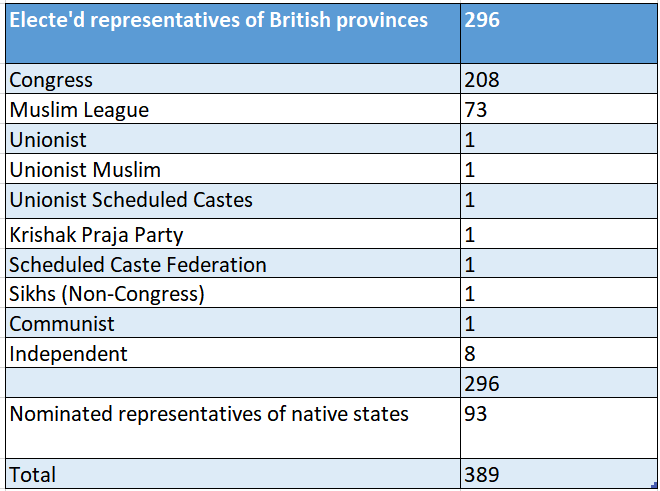Chapter 9 Constitution Of India: Democratic Structure And Citizen’s Rights Topic C Miscellaneous Strike The Odd One Out
Question 1. Chief Minister, Professor, Doctor, Barrister.
Answer: Chief Minister
Question 2. Panchayat, Municipal Corporation, Zilla Parishad, Club.
Answer: Club
Question 3. High Court, District Court, Zilla Parishad, Supreme Court.
Answer: Zilla Parishad
Question 4. Vice President, Speaker, Election Commission, Governor.
Answer: Election Commission
Question 5. Chairman of Zilla Parishad, Block Chairman, Gram Pradhan, Councillor.
Answer: Councillor
Question 6. Scheduled Caste, Harijans, Dalit, Brahmin.
Answer: Brahmin
Read and Learn More WBBSE Solutions For Class 8 History
Question 7. Zilla Parishad, Panchayat Samiti, Bidhan Sabha, Gram Panchayat.
Answer: Bidhan Sabha
Question 8. Right to equality, Right to work, Right to freedom, Right to Religion
Answer: Right to work
Question 9. Pranab Mukherjee, Pratibha Patil, APJ Abdul Kalam, Dr. Manmohan Singh.
Answer: Dr. Manmohan Singh
Chapter 9 Constitution Of India: Democratic Structure And Citizen’s Rights Topic C Miscellaneous Match The Columns
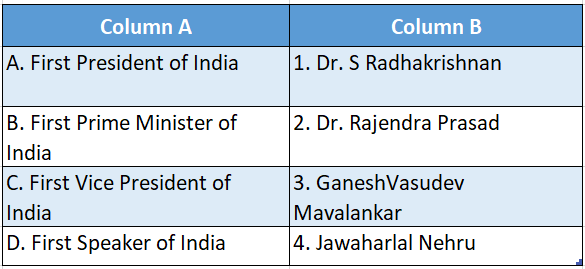
Answer: A-2,B-4,C-1,D-3
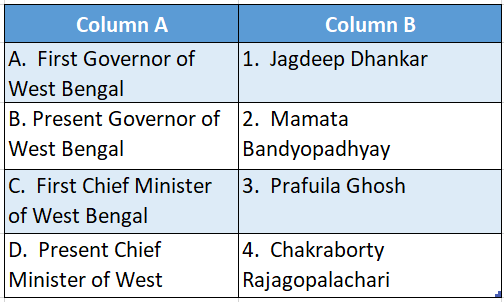
Answer: A-4,B-1,C-3,D-2
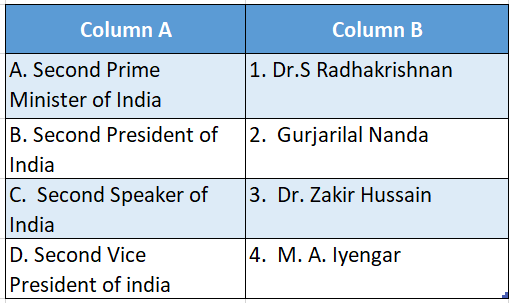
Answer: A-2,B-1,C-4,D-3
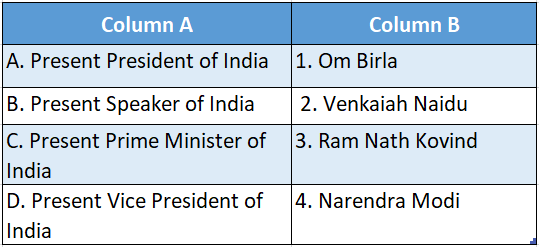
Answer: A-3,B-1,C-4,D-2
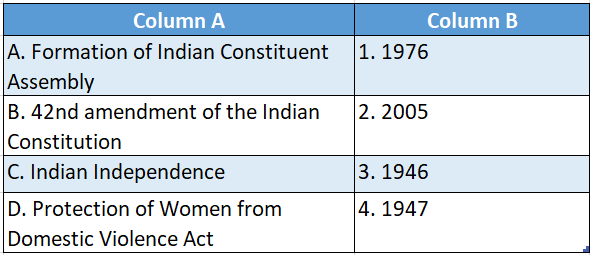
Answer: A-3,B-1,C-4,D-2
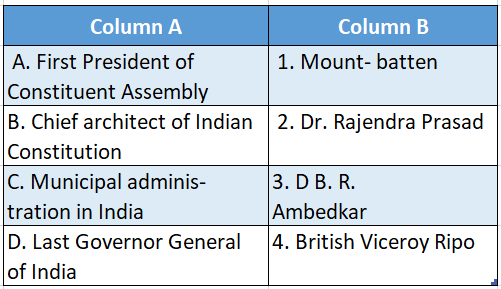
Answer: A-2,B-3,C-4,D-1
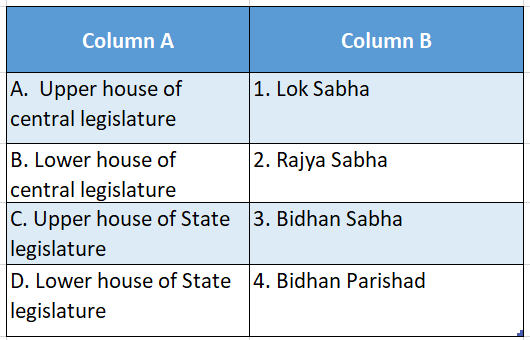
Answer: A-2,B-1,C-4,D-3
Chapter 9 Constitution Of India: Democratic Structure And Citizen’s Rights Topic C Miscellaneous Find The Odd One Out
Question 1. Secular, sovereign, Capitalist democratic
Answer: Capitalist
Question 2. President, Vice President, Prime Minister, Governor.
Answer: Governor
Question 3. Municipality, Lok Sabha, Rajya Sabha, Bidhan Sabha.
Answer: Rajya Sabha
Question 4. Dr. Rajendra Prasad, Dr. Sarvapalli Radhakrishnan, Jawaharlal Nehru, B.R. Ambedkar.
Answer: B.R. Ambedkar
Question 5. 15th August 26th January, 26th November, and 20th March (based on independent India).
capitalistic,
Answer: 20th March
WBBSE Class 8 Miscellaneous Notes on Constitution
Chapter 9 Constitution Of India: Democratic Structure And Citizen’s Rights Topic C Miscellaneous Choose Which Statement Is Right And Which Wrong
Question 1. The constitution is a collection of laws of the judiciary.
Answer: False
Question 2. The chief architect of the Indian Constitution is B.R. Ambedkar.
Answer: True
Question 3. The President is the actual administrator of India.
Answer: False
Question 4 The Chief Minister presides over the Rajya Sabha.
Answer: False
Question 5 West Bengal has a three-tier Panchayat system.
Answer: True
Answer briefly
Question 1. Why was a need felt for drawing up the Constitution of India at the time of achieving freedom?
Answer:
A Need Felt For Drawing Up The Constitution Of India At The Time Of Achieving Freedom:-
1 Ruling the state of India:
India became independent on August 15, 1947. Since the newborn state was an institution, its affairs had to be conducted legally.
So it was necessary to frame a constitution.
In the context of the state, the constitution is a set of laws by which the powers and functions of government, the rights of citizens, and the relationship between the state and citizens are conducted.
Understanding the Preamble of the Indian Constitution
2. Fulfilment of the demands of Indians and solution of problems:
In British India, the demands of the Indians were not satisfied. Again, several problems had to be. Faced with the newly independent state.
So the Indian Constitution was framed to fulfill the demands of the Indians and to solve all their problems.
Question 2. Explain the significance of the word ‘democratic in the Constitution of India.
Answer:
Significance Of The Word Democratic In The Constitution Of India:-
1 Wider meaning:
In a wider sense, the word ‘democratic’ in the Indian Constitution means the establishment of equality in social, economic, and political fields.
2. Real meaning:
In the real sense, the word democratic means the selection of rulers through an adult franchise.
In India, the administration is conducted by representatives elected through a universal adult franchise.
From this point of view, it can be said that the Indian administrative system is democratic.
Question 3. Why is India called a secular state?
Answer:
Secular State:-
The Constitution describes India as a secular country.
1. Secularism:
India maintains a neutral role in the matter of religion. Every person, irrespective of race, religion, caste, and gender, can practice, preach, and propagate his religion.
2. Impartiality:
India is not biased toward any religion. This means that India neither supports nor opposes any religion.
However, for the wider interest of all Indians, the state may at times impose some reasonable restrictions on the right to religion.
Key Features of the Indian Constitution Explained
Question 4. What initiatives were taken up by Mahatma Gandhi to establish the rights of the Dalits?
Answer:
Initiatives Were Taken Up By Mahatma Gandhi To Establish The Rights Of The Dalits:-
Gandhiji took several initiatives to establish the rights of the Dalits.
Class 8 WBBSE History Question Answer
1. Foundation of All India Harijan Sangh:
Gandhiji founded the All India Harijan Sangh for the overall welfare of the Dalits and Harijans.
This organization organized and directed movements to establish the rights of the Dalits and to oppose untouchability.
2. Attempt to grant the right to education:
Gandhiji set up several educational institutions to grant the right to education to the Dalits under the initiative of Harijan Sevak Sangh.
Here are the Dalits. Were given free education.
3. Grant right to enter temples:
Inspired by Gandhiji’s ideals the Bombay Congress passed a law to allow the Dalits and the Harijans to enter temples.
4 Grant other rights:
Sweepers’ Union, Abasan Samiti, and Samavaya Hrin Samiti grew up with Gandhiji’s active help. Their personalities are called Fundamental Rights.
Impact of the Constitution on Indian Society
Question 5. What Fundamental Rights have been mentioned in the Constitution of India?
Answer:
Fundamental Rights Have Been Mentioned In The Constitution Of India:-
1. Definition:
The rights of the citizens are unavoidable for the development
2. Different forms:
The Indian Constitution mentions six Fundamental Rights. These are
- Right to Equality,
- Right to Freedom,
- Right against Exploitation,
- Right to Freedom of Religion,
- Cultural and Educational
- Rights and Right to Constitutional Remedies.
3. Rectification:
Initially Right to Property was included in the Fundamental Rights but this right was removed from the category of Fundamental Rights by the 44th Amendment carried out in 1978.
Write In Your Own Words
Question 1. Explain the Preamble to the Constitution of India. How do you think the word ‘Republic’ mentioned in the Preamble has been realized?
Answer:
Explanation Of The Preamble
1. Explanation of the Preamble:
1. Sovereign:
‘Sovereign’ means India is completely free from foreign control, both internally and externally, and possesses supreme power.
2. Socialist:
Although the Preamble describes India as a socialist state, socialism has not been established in the real sense of the term. Here mixed economy is discernible.
Short Notes on Fundamental Duties
3. Secular:
As a secular country India neither supports nor opposes any religion. All religions get equal recognition here.
4. Democratic:
Democratic means the Indian administration is based on public opinion.
5. Republic:
Republic means that the post of the head of the state is not hereditary and is elected by the public directly or indirectly.
Dispute Over Achievement Of ‘Republic’-

1. Meaning of ‘Republic’:
The word ‘republic’ means the rule of the people or the subjects. It implies that the head of the state does not hold his post hereditarily.
He is indirectly elected by the public. Here there is no place for a king or monarchy.
According to the Constitution of India, the source and guardian of the Indian administration are the people.
So the Indian constitution contains the word ‘republic’.
2. Realisation or achievement of the republic:
In India republic exists according to the Constitution. This is because it is through the vote of the public that the party winning the majority of votes comes to power.
The leader of the party becomes the Prime Minister. Apart from this, the Indian administration has the President at its head.
He is also indirectly elected by the people through their elected representatives. So it can be said that in India the supremacy of the public has been recognised.
So the word ‘republic’ mentioned in the Constitution has been achieved.
Question 2. Discuss the activities of the Prime Minister of India and the Chief Minister of a state: What are their respective roles in the governance of the century and the state?
Answer:
The Activities Of The Prime Minister Of India And The Chief Minister Of A State Respective Roles In The Governance Of The Century And The State:-
Introduction:
The Constitution does not give a detailed explanation of the powers and functions of the Prime Minister.
The powers and functions have been determined on the model of the Prime Minister of England and also on the basis of the prevalent rituals and practices.
Practice Questions on Constitutional Rights
Powers And Functions Of Prime Minister-
1. Chief Advisor to the President:
According to Article 74. cl.1. the Prime Minister is the Chief Advisor to the President.
According to the 42nd Amendment the President is bound to obey the Prime Minister’s advice.
2. Link between the President and the Cabinet:
The Prime Minister acts as a connecting link between the President and the Cabinet ministers.
He informs the President about the proceedings of the administration and legal proposals or bills.
3. Leader of Cabinet:
The Prime Minister is the leader and chief director of the Cabinet. All the other Cabinet ministers are appointed by the President on his advice.
He also has the power to distribute departments and assign tasks to the ministers of the Cabinet.
4. Authority over the Cabinet:
The Prime Minister has full authority over his Cabinet.
He has the power to determine the agenda of the Cabinet, to advise the ministers, and to maintain coordination among the various departments. According to Dr. V. D. Mahajan,
“The Prime Minister is like a moon among the stars.” Again, others have described him as ‘the foremost among people of the same status.’
Class 8 History WBBSE
5. Leader of Parliament:
The Prime Minister is appointed as the leader of the majority party in the Lok Sabha. So he is the leader of the house also.
He can be present in either house (Lok Sabha and Rajya Sabha) of the parliament.
He possesses the power to fix the date for meetings, determine the duration of sessions, and prepare the agenda.
6. Determining foreign policy:
The Prime Minister plays an important role in determining Foreign policy. The Prime Minister’s opinion is final in the matter of employing ambassadors.
7. Popular leader:
The Prime Minister is directly elected by the people.
So he acts as a link between the government and the public.
He conveys the aims, objectives, and agenda of the government to the public at a scheduled time.
The Chief Minister is the real administrator of the state and plays a vital role in the state administration.
1. Conducting administration:
A Cabinet of ministers conducts the state administration under the leadership of the Chief Minister.
The governor appoints the members of the Cabinet on the recommendation of the Chief Minister.
2. As the Governor’s advisor:
The Chief Minister is the Chief Advisor to the Governor. The Governor transacts all activities according to the Chief Minister’s advice.
3 Public Relations:
An important task of the Chief Minister is to maintain public relations.
The Chief Minister has to determine the government policies and carry on the activities according to public opinion.
4. Leader of Bidhan Sabha:
As a leader of the Bidhan Sabha, the Chief Minister calls sessions, postpones them, and dissolves the Bidhan Sabha if necessary.
Question 3. How is the idea of democracy emphasized through local self-government in West Bengal? Discussconcerningo your local experience.
Answer:
The Idea Of Democracy Emphasized Through Local Self-Government In West Bengal Concerning Your Local Experience:-
Introduction:
There is a local self-government system in West Bengal. It includes the three-tier system of the Gram Panchayat and the Municipal Corporation of the cities.
The rural system includes Gram Panchayat, Panchayat Samity, and Zilla Parishad. Through this system of five years, the democratic system is implemented.
Local Self Government System And Democracy.
The three-tier system in the village:
1. Public participation:
An important feature of a democratic administrative system is the introduction of the local self-government system.
The common people can easily participate in this administrative system.
Class 8 History WBBSE
Anybody can participate as a public representative by winning a municipal or panchayat election. These representatives conduct the local self-government system.
2. Representation through election:
The members of the local self-government system are elected by universal adult franchise.
One person represents 700 voters in a gram panchayat, one represents 4,500 in Panchayat Samiti and one represents 60,000 in Zilla Parishad.
3. Conduction of administration:
The local self-government is conducted democratically. The members of Panchayat Samity and Zilla Parishad democratically conduct public welfare work.
Important Definitions Related to Indian Democracy
Question 4. How does the Indian Constitution secure the rights of women? How important do you think economic Independence is necessary for the social empowerment of women?
Answer:
The Indian Constitution Secure The Rights Of Women And The Importance That I Think Economic Independence Is Necessary For The Social Empowerment Of Women:
Introduction:
In the Constitution of independent India, some rights have been granted to women.
They have been granted the right to participate in politics, the right to freedom, right to legal security.
Women’s Constitutional Rights
1. Right to participate in politics:
According to the 73rd and 74th amendments, one-third (33%) of seats have been reserved for women in Gram Panchayat and Municipal Corporation.
Therefore, the power and prestige of women, as people’s representatives in the local self-governed institutions, have increased.
2. Education System:
The Constitution also provides for equal educational opportunities for men and women.
According to articles 29 and 30 which deal with the rights to culture and education, attempts have been made to raise the social prestige of women by providing them with proper education.
3. Marriage system:
Some matrimonial laws were passed to improve the condition of women like the Widow Remarriage Act (1856), the Special Marriage Act (1954),
Hindu Marriage Act (1955) and Hindu Adoption and Maintenance Act (1956).
The main issues were the age of marriage, polygamy, divorce, alimony, widow remarriage, dowry, and adoption.
Class 8 History WBBSE
4. Right to property:
The right of women to the property has been recognized. A wife, mother, unmarried daughter, and widow can inherit property.
According to the Hindu Inheritance Act (1956), brothers and sisters have equal rights on the father’s property.
A deceased person’s widow, son, and daughter will have equal claim on his property.
5. Fundamental Rights:
Articles 12 to 35 in Part III of the Indian Constitution deal with Fundamental Rights.
The Right to Equality reduces the discrimination between men and women and the Right to Freedom grants women the right to express their opinions freely and live independent lives.
The other Fundamental Rights also protect the interests of women.
The state is also empowered to take necessary measures for the protection of the interests of women.
Need For Economic Independence To Establish Social Status Of Women
To consolidate women’s empowerment it is necessary to grant them more economic independence.
Like men, the social status of women is also dependent on economic freedom.
Economic independence not only grants social status and prestige to women but also reduces oppression and exploitation.
Moreover, economic freedom increases their self-confidence. Consequently, they can combat or resist all the problems in the path of life.
Question 5. What role has been played by the Indian Constitution in the development of Scheduled Castes, Scheduled Tribes, and Other Backward Classes?
Answer:
Role Has Been Played By The Indian Constitution In The Development Of Scheduled Castes, Scheduled Tribes, And Other Backward Classes:-
Introduction:
The Constitution contains some provisions for the development of citizens belonging to Scheduled Castes, Scheduled Tribes, and Other Backward Classes.
Part XVI of the Constitution contains some special measures for the Scheduled Casts and Tribes.
Role Of the Constitution In the Development Of Other Backward Classes
1. Right to Equality:
Article 15 of the Constitution mentions equal social prestige for all citizens.
Article 16 states that all Indian citizens will be given equal opportunities for appointment government jobs and high posts.
Class 8 History WBBSE
2. Elimination of untouchability:
Article 17 of the Constitution advocates, the abolition of untouchability.
No person can be deprived of his due privileges and rights or insulted simply on the grounds of caste or untouchability.
Such actions will be regarded as legally punishable offenses.
The parliament passed the Offence of Untouchability Act in 1955 to put an end to untouchability.
3. Reservation in government jobs and education:
In government jobs, 15% of seats for Scheduled Castes and 7.5% for Scheduled Tribes have been reserved.
27% of seats have been reserved for the backward classes on the recommendation of the Mandal Commission.
The same provisions apply in the educational sphere also. However, some changes have been made in the reservation procedure from primary school to the university
through a circular issued by the Government of West Bengal in 1944. According to this circular 22% and 6% seats have been reserved for
the Scheduled Castes and Scheduled Tribes. Respectively in government-recognized educational institutions.
4. Appointment of officers:
The President can appoint a special executive officer for the overall welfare of the Scheduled Castes, Scheduled Tribe, and other backward classes.
Article 338 of the Constitution mentions such a provision.
The task of such an officer is to research the facilities or provisions meant for the Scheduled Castes Tribes and Other Backward Classes.
The officer submits his report to the President who then places it before the parliament.
5. Other arrangements:
- The Central Government provides special grants to the state governments. For the welfare of the Scheduled Castes, Scheduled Tribes, and Other Backward Classes.
- The Parliament has a stable committee to see that the welfare measures are being carried out according to the terms of the Constitution.
Apart from this, Article 15. cl.4, Article 16. cl.4 and Article 5 contain different measures for their welfare.
Class 8 History WBBSE
Imagine and write
Question 1. Suppose the residents of your area have elected you as their representative to your Gram Panchayat or Municipality. What steps would you take for the development of your area?
Answer:
Steps I Would Like You Take For The Development Of My Area:-
Introduction:
If I am elected to the Gram Panchayat or the Municipal Corporation then I shall work hard for the overall development of my locality.
Programs For the Development Of Locality
1. Water supply:
I shall see to it that water is adequately supplied to all parts of my locality. I shall also take the initiative to clean the sources of water and keep them germ-free.
2. Adoption of self-reliant strategies:
I shall arrange exhibitions to create markets for local agricultural and handicraft commodities.
Apart from this, I shall set up and control markets, fairs, and haats to help the villagers become self-dependent.
3 Public welfare:
I shall dig public ponds, maintain crematoriums and graveyards, build inns, rest houses, and guest houses, and supervise them.
I shall also initiate the ambulance service to carry patients.
4. Public health preservation:
I shall take preventive measures for cholera, smallpox, malaria, and other epidemics. At the same time, I shall set up health centers, child delivery centers, and child welfare centers.
I shall also build some public toilets and maintain them.
5. Electrification:
I shall take up the initiative of supplying electricity to every house and arrange for street lights on either side of the road.
I shall campaign for wider use of biogas and other unconventional sources of energy.
6. Environment protection:
I shall take some initiatives to protect the environment.
I shall arrange for proper garbage disposal, proper sewage, and tree plantation and care. I will also work to generate awareness.
7. Road building and maintenance:
Conceptual Questions on Rights and Responsibilities in India
I shall build roads for public use and maintain them. I shall also protect public roads and places from illegal occupation.
8. Service of the destitute:
I shall look after the sick and the orphans. I shall try to rehabilitate the homeless. I shall help to build houses for the disabled, orphans, and homeless people.
I shall help the poor and backward classes to earn their livelihood.
9. Others:
I shall reclaim inferior lands and make them usable. I shall also take up home-building programs and build agricultural cooperatives.
I shall set up statues of great personalities. I shall try to elevate the standards of adult education, physical education, games and sports, music, theatre, and other cultural activities.
Question 2. Suppose you are a teacher. What program would you take up along with the students of your school to carry out together the fundamental duties mentioned in the constitution? Prepare a draft of the program.
Answer:
I Would Like To Take Up Along With The Students Of Our School To Carry Out Together The Fundamental Duties Mentioned In The ConstitutionA Draft Of The Program:-
Introduction: As a school teacher, I shall first give an idea of Fundamental Duties to my students. I shall arrange various programs with them to inculcate a sense of these duties.
Draft For Performing Fundamental Duties
1. Literacy Campaign:
It is mentioned in the Fundamental Duties that parents and guardians should provide education to all children between 6 and 14 years.
I shall campaign in the villages around the school to provide education. I shall involve my students to fulfill this fundamental duty.
2. Youth’s Day Celebration:
Swami Vivekananda’s birthday on January 12 is celebrated as National Youth’s Day. On this day we, teachers and students, will organize a program.
Here we will take up the ideals of patriotism and public service in conformity with the Fundamental Duties in the Constitution.
3. Celebration of Netaji’s Birthday:
We shall organize a program for Netaji’s birthday on January 23. On this day we shall take oaths of patriotism and defense of the country as a part of our Fundamental Duties.
There will be recitations of patriotic poems and literature and a procession with festoons and placards bearing Netaji’s photograph and speeches.
4. Celebration of Republic Day:
We shall take up some programs on January 26 to celebrate Republic Day as a part of our
‘Fundamental Duty’.
We, the teachers, shall put up the Constitution of India and its ideals before our students. We shall organize a morning musical procession. (Prabhat Pheri) from our school.
5. Science Day celebration:
February 2 is celebrated as Science Day in India. The Fundamental Duties mention ‘building up scientific mentality, inquisitiveness, and reformative attitude’.
According to this idea, we shall arrange a seminar on scientific topics in our school.
6. Celebration of Independence Day:
On August 15 we shall arrange for a discussion on the ideas of sovereignty, unity, and integrity as stated in Fundamental Duties.
We shall also organize a procession on behalf of our school to honor the national heroes and patriotic songs will also be sung.
7. Celebration of National Unity Day:
National Unit Day is observed on November 19. On this day we, along with the students, will take an oath of unity and brotherhood by Fundamental Duties.
We shall organize a debate in school on the need to establish fraternity rising above the difference of religion and caste.
8. Celebration of Flag Day:
The Flag Day is celebrated on December 7.
On this day, along with hoisting the National Flag, the children are also reminded that it is the duty of all of us to maintain and uphold the prestige of our national flag.
Additional Information
National Flag
1. Acceptance:
On July 22, 1947, the National Flag was approved by the Constitutional Committee.
The flag was hoisted at the Parliament House on the midnight of the 14th of August and it was dedicated in the name of the nation by the Women’s Society of India.
Class 8 History Solution WBBSE
2. Background of the present National Flag:
The All India Congress Committee met at Bejubara in 1916. In this meeting, a youth from Andhra Pradesh Pingali Venkaiya showed a model of the national flag.
Gandhiji added the white color and the wheel to it and gave it its present form.
3. Measurement:
The ratio of the length and breadth of the flag is 3:2. The three color bands have equal width.
4. Significance of the colors used:
The upper part contains saffron color which symbolizes | the Kolkata session of the National Congress.
The sacrifice and courage, the middle portion is white which symbolizes peace and truth, and the green color at the lower portion symbolizes faith and valor.
5. Chakra:
A wheel of Ashoka is drawn in blue on the white portion. It has been derived from the top of the lion pillar at Sarnath.
There are twenty-four spokes in it. It symbolizes our ancient culture as well as progressive and peaceful transformation.
National Emblem
1. Acceptance:
The Indian government accepted the Ashokan pillar as the national emblem on January 26, 1950. It was a model of the Ashokan Pillar at Sarnath.
2. Description:
The main pillar contains the model of four lions standing side by side and back to back. However, only three of them are visible on the emblem.
The pillar is placed on an altar and there is a wheel in the middle. There is an ox and a horse on the right and left sides respectively.
Below it, there is a transcription in Devanagari script and it is derived from Mundak Upanishad.
The inscription contains the words ‘Satyameva jayate’ meaning ‘truth always wins’.
3. Source:
This pillar, which is now used as the National Emblem, was built by emperor Ashoka in 242-232 BC.
It was built at the place where Buddha had given his first sermon to his disciples on ‘Ashtanga Marga’.
National Anthem
1. Background:
The song ‘Jana Gana Mana was first sung on December 27, 1911, in the first stanza of this song which was published.
The title of ‘Bharat Vidhata’ in ‘Tatavabodhini’ (a journal edited by Rabindranath) in January 1912 became our national anthem later on.
2. Period:
It takes 52 seconds to sing the song but in some cases, the first and last stanza (the brief edition) takes 20 seconds to sing.
National Anthem: Jana Gana Mana
Composer: Rabindranath Tagore.
Examples of Landmark Supreme Court Cases
2. Acceptance as national anthem: The Indian Parliamentary Committee accepted it as the national anthem on January 24, 1950.
3. English Translation: Rabindranath Tagore himself translated it into English in 1919 and named it ‘Morning Song of India’.
National Song Or Hymn
1. Background:
‘Vandemataram’ is a song that was included in the novel ‘Anandamath’ written by Bankim Chandra Chatterjee in 1882.
Rabindranath first presented the song in 1896 at the conference of the Indian National Congress. Later on, this song was included in the Indian Republic as the National Hymn.
2. Source: Anandamath
3. Composer: Bankim Chandra Chatterjee
4. Acceptance as National Song:
On January 24, 1950, the Indian Parliamentary Committee accepted it as the National Song.
5. English translation:
Aurobindo translated it into English in 1909 saying, ‘Mother, I bow to thee’.
Prime Ministers of India
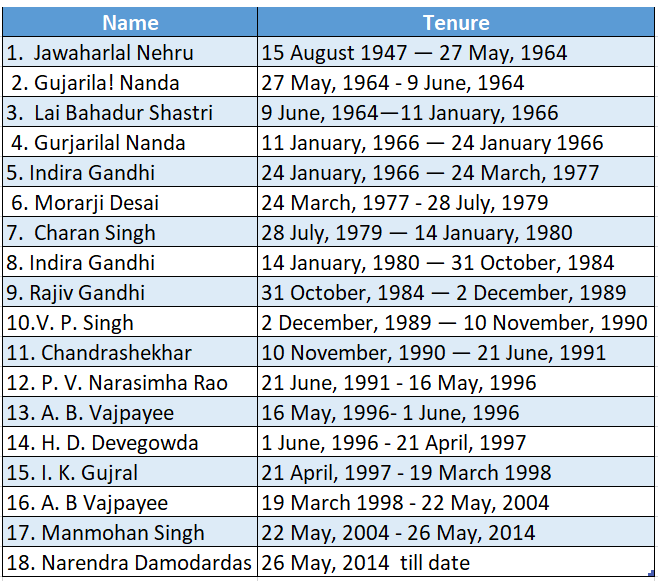
Presidents Of India
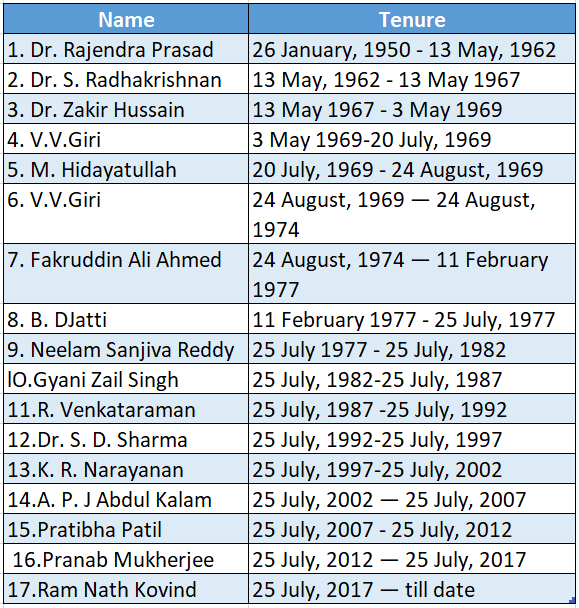
Vice Presidents Of India
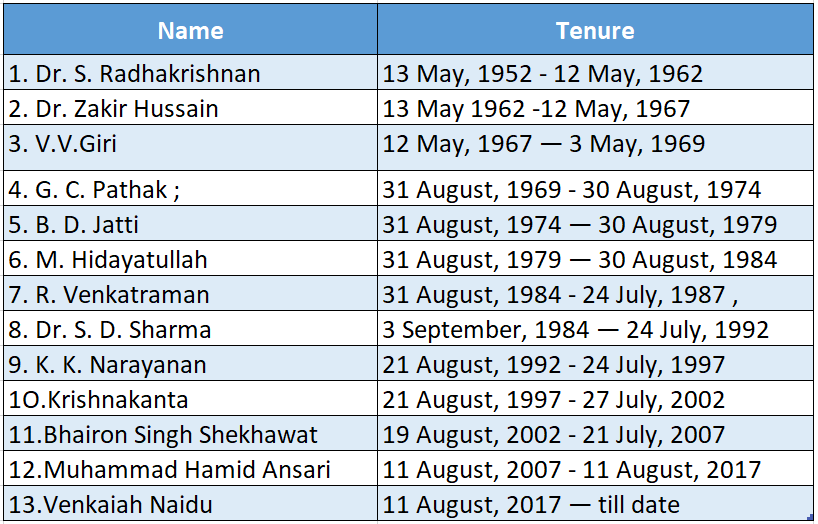
Speakers Of Lok Sabha
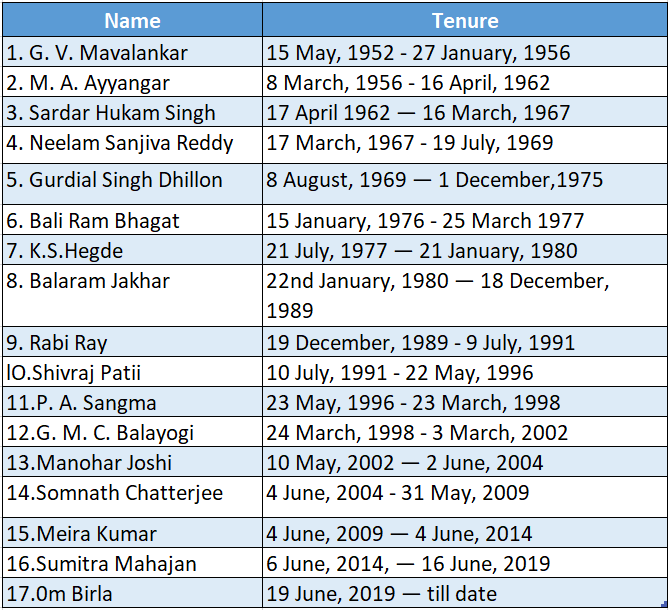
Governors Of West Bengal
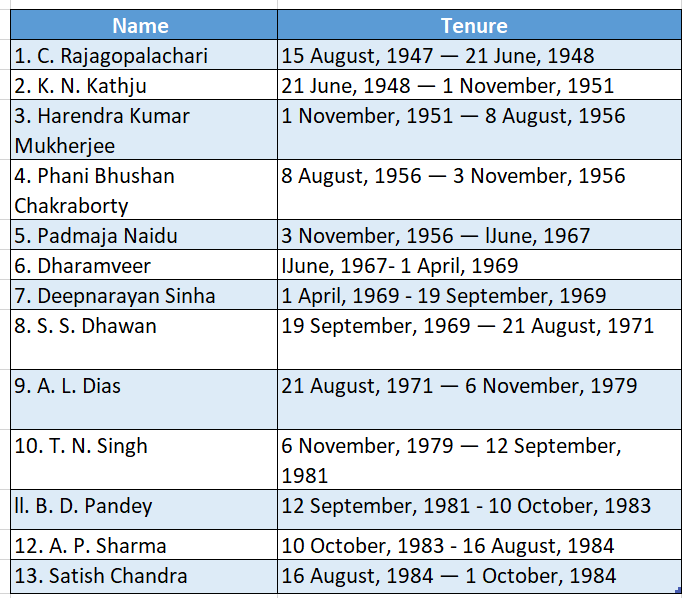
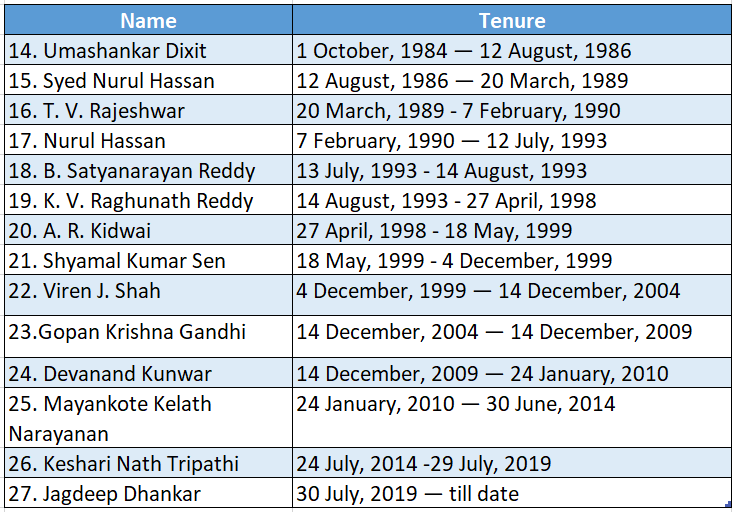
Chief Ministers Bangal
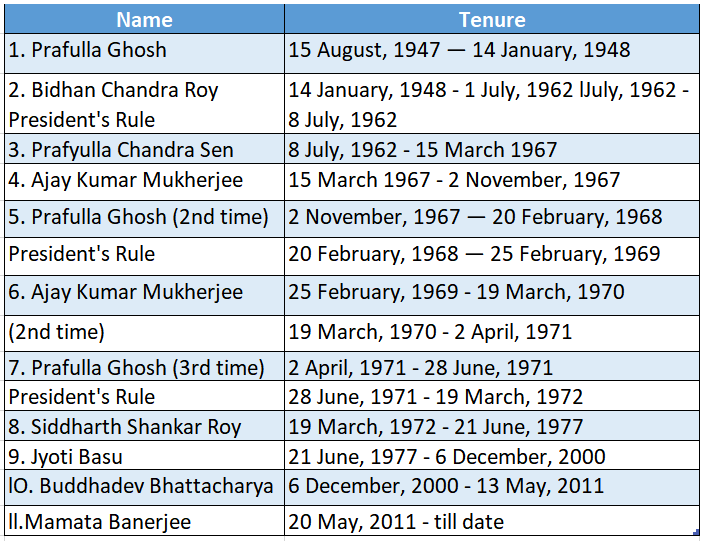
National Event
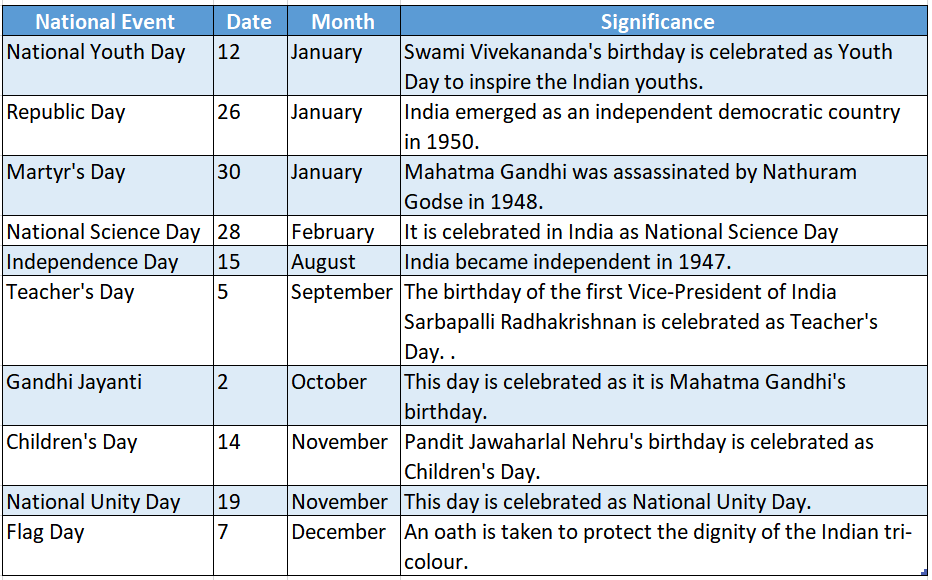
Structure Of Constituent Assembly (1946)
